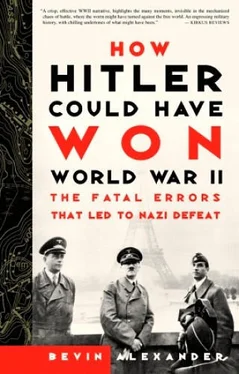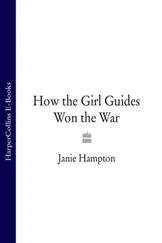Meanwhile, Erich von Manstein, who had been given command of 11th Army with orders to seize the Crimea, reached the neck of the peninsula on September 29, and by November 18 had driven most of the surviving Russians into Sevastopol. Attacks against the fortress failed, and Manstein finally called off the effort on December 30, 1941. Meanwhile, Russians landed on the Kerch peninsula in the eastern part on December 26 and tried to reconquer the Crimea. With great difficulty Manstein sealed off the peninsula, but anticipated that the Red Army would make another attempt in the spring of 1942.
With the conclusion of the Kiev encirclement, Hitler at last was ready to attack Moscow. He ordered it, code-named Operation Typhoon, to commence on September 30. The principal aim was the destruction of Soviet forces blocking the road to the Soviet capital “in the limited time which remains available before the onset of the winter weather.”
He transferred back Hoth’s and Guderian’s panzer groups, and sent along all but one corps (Rudolf Schmidt’s 29th) of Hoepner’s group from Army Group North. In theory Army Group Center’s commander, Field Marshal Fedor von Bock, had a formidable force in the panzer formations, plus 4th Army (Kluge), and 9th Army (Strauss), a maneuver mass of seventy divisions.
But the German army as a whole had lost half a million men since June 22. Almost no units were at full strength. Many of the 600,000 horses the Germans had brought into Russia to carry supplies were dead, and there were no replacements. Ammunition had to be left on the sides of the roads. The simplest necessities disappeared—razor blades, soap, toothpaste, shoe-repair kits, needles and thread. The sick could not be left in the rear, because the forests behind were infested with partisan guerrillas. Rain began in September with cold northeast winds. Shelter everywhere was inadequate or nonexistent. Boots were falling apart, clothing turning into rags.
The infantry divisions were 2,000 to 4,000 men below strength. The three panzer groups (thirteen panzer and seven motorized divisions) possessed only about a thousand tanks altogether. Still they were superior to the 480 tanks (only forty-five new T-34s and KV-1s, both with high-velocity 76-millimeter guns) that Ivan S. Konev’s Western Front had to oppose them.
The Russians had had two months to build field fortifications across the approaches to Moscow, and about 800,000 men were facing them. But they were mostly raw replacements with little training and poor leadership.
German panzers broke the Russian front in five places. Guderian drove northeast from Sostka to Orel, eighty miles south of Moscow. His advance was so rapid that the electric streetcars were still running in the city, and evacuations of factories were under way as his tanks rolled in. Workers had to abandon machinery and tools on the streets.
Guderian then turned west on Bryansk. With the help of 2nd Army to the west and Hoepner’s Panzer Group 4 to the north, he trapped thousands of Russians south and west of Bryansk. Meanwhile 4th and 9th armies and Hoth’s Panzer Group 3 formed another caldron west of Vyazma (only 135 miles from Moscow).
The battles were turbulent. Frequently German troops were cut off and had to fight their way free. Russian aircraft bombed frequently, but flew so high their aim was inaccurate. Counter strokes by T-34 and KV-1 tanks led to critical battle situations.
Guderian commented on a collision of 4th Panzer Division northeast of Orel on October 11: “Numerous Russian T-34s went into action and inflicted heavy losses on the German tanks. Up to this time we had enjoyed tank superiority, but from now on the situation was reversed.”
German tankers found that the short-barreled 75-millimeter gun on the Mark IV could knock out a T-34 only if it could hit the grating above the engine in the rear, a shot rarely possible. The 480-mile-wide battlefield was covered with fallen soldiers, dead horses, shot-up tanks, and the first American jeeps.
Stalin had rushed many militiamen with virtually no training into ranks, and large numbers of them gave up without a fight. Once more, linear Russian dispositions had allowed the Germans to break through at selected points and surround great bodies of troops. On October 13, resistance in the Vyazma caldron ceased. A week later the last Russians surrendered in the Bryansk pocket. The Germans counted 650,000 prisoners altogether, almost as many as were taken in the Kiev caldron.
There were now very few Soviet soldiers between the Germans and Moscow. The entire Soviet army in European Russia was down to 800,000 men and 770 tanks. But the situation had changed radically since August. The first snow fell on October 7. It melted quickly, but was followed by heavy rains.
“The roads rapidly became nothing but canals of bottomless mud,” Guderian wrote, “along which our vehicles could only advance at a snail’s pace and with great wear to the engines.”
In the crisis, Stalin brought Georgy Zhukov back from Leningrad on October 10 to direct the defense of Moscow. Panic was setting in among the people. Rumors of advancing Germans spread widely. People began to flee from the city.
Zhukov stilled the panic by mobilizing every person he could find to build antitank ditches outside the city. A quarter of a million people, three-quarters of them women, did the work by hand with shovels, spades, and buckets. Using whatever troops he could find, Zhukov manned the Mozhaisk line, the Russians’ last defensive position, running from the “Sea of Moscow,” a reservoir on the Volga River seventy miles north of the city, in a semicircle around to the Oka River, fifty-five miles south of Moscow.
Stalin ordered the Soviet government along with all top officials, the diplomatic corps, and many specialists to evacuate 420 miles east to Kuybyshev, north of the Caspian Sea.
But Stalin did not leave and did not lose his nerve. He lived in a small villa far outside the Kremlin, and worked mostly in the nearby subway station Kirovskaya, where the Stavka high command also operated. On October 5 he had received a radio message from his spy Richard Sorge in Tokyo that the Japanese would go to war with the United States in the next few months. This meant that the huge army he was maintaining in the Far East no longer was needed, and he ordered twelve divisions with 1,700 tanks and 1,500 aircraft (altogether 250,000 men) in eastern Siberia and Outer Mongolia to come to the defense of Moscow. Until their appearance weeks would go by. Whether the Soviets would get that much leeway depended principally upon the weather.
Rasputitsa, the period of mud, reached its high point. Vehicles sank to the hubcaps. The entire German supply system was hobbled.
But on November 2, 1941, the weather began to improve. A light frost permitted the troops to become mobile. Artillery pieces were dragged out of the mud. Trucks could roll once more. Train lines reopened.
Bock ordered a final great exertion to reach Moscow by means of a double-sided encirclement. In the center 4th Army (Kluge) was to hold the enemy by a frontal attack. On the north Panzer Groups 3 and 4 were to fight to the Moscow-Volga canal running up to the Sea of Moscow. On the south Guderian was to advance past Tula to Kolomna, on the Oka River about sixty miles southeast of Moscow.
This final offensive went down in the annals of the German army as “die Flucht nach vorn,” or “the flight to the front”—a desperate attempt to get into the shelters of Moscow before the onset of winter.
The attempt began on November 15 in clear frosty weather. The panzer units of the northern wing gained a bridgehead across the canal at Dimitrov, and one division came within eighteen miles of Moscow at Krasnaya Polyana. Guderian went around toughly defended Tula and approached Kashira, only thirty-two miles from Kolomna.
Читать дальше


![Джонатан Димблби - Barbarossa - How Hitler Lost the War [calibre]](/books/385421/dzhonatan-dimblbi-barbarossa-how-hitler-lost-the-w-thumb.webp)









